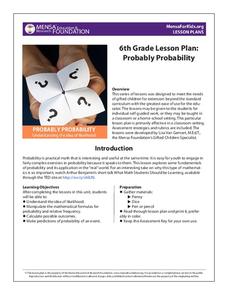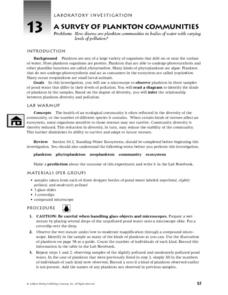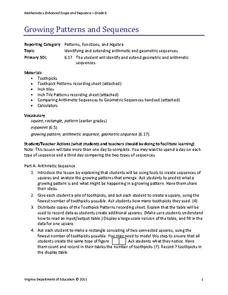School Specialty
The Tortoise and the Hare - Drawing Conclusions/Predictions Outcomes
Does the fastest one always win the race? Look deeper into The Tortoise and the Hare with a set of discussion questions for before, during, and after reading the story.
Have Fun Teaching
Predict and Infer (22)
Encourage close reading and critical thinking with a instructional activity that asks readers to select an event from a story, predict what they believe will happen, and list clues from the story that support this prediction. After...
Curated OER
Making Predictions
For this predictions worksheet, students look at a set of 3 pictures, then draw and write a prediction about what might happen next.
Curated OER
Making Predictions
In this predicting outcomes worksheet, students use the information they already know and what the author is telling them to make a prediction. Students read several short passages and then write their predictions on the line.
Curated OER
Predicting Outcomes I: Post Test
In this predicting outcomes worksheet, students complete multiple choice questions about how to predict outcomes of a situation. Students complete 8 questions total.
Curated OER
Predicting Outcomes I: Pre Test
In this predicting outcomes activity, students answer multiple choice questions about predicting outcomes of different stories. Students answer 8 questions total.
Raytheon
Probability, Percent, and Proportion
In this probability and predictions learning exercise, middle schoolers read 1 page of facts, then solve 8 pages of problems related to probability, with answers keys included.
Houghton Mifflin Harcourt
Three Skeleton Key
Encourage your learners to interact with the text as they read. While reading "Three Skeleton Key," class members note predictions, define words and study their meanings, take notes on how the suspense builds, and jot down ideas about...
MENSA Education & Research Foundation
Probably Probability
Reinforce the concept of probability with a series of lessons highlighting the idea of likelihood, probability formulas, relative frequency, outcomes, and event predictions. The collection is made up of four lessons offering informative...
Curated OER
School-Home Links/Book Links: Predictions
For this making predictions worksheet, students learn how to make predictions when reading. Students study the book cover, pages, and predict the story's outcome. Students make another prediction halfway through and then assess their...
August House
The Great Smelly, Slobbery, Small-Tooth Dog
Read the story The Great Smelly, Slobbery, Small-Tooth Dog: A Folktale from Great Britain by Margaret Read MacDonald and choose from multiple activities to learn about the tale's theme—kindness. With so many options, your kind kids will...
Perfection Learning
Of Mice and Men by John Steinbeck: Clouds on the Horizon--Foreshadowing
The seeds of tragedy are planted early in John Steinbeck's story of migrant workers George Milton and Lenny Small. Nurture the imagination of readers by asking them to craft predictions about what will grow out of events in chapters one...
Curated OER
Using Random Sampling to Draw Inferences
Emerging statisticians develop the ability to make inferences from sample data while also working on proportional relationships in general. Here, young learners examine samples for bias, and then use random samples to make inferences...
Tracy Pendry
Cardiovascular/Circulatory System
Explore the circulatory system with a cardiovascular pump activity that promotes discovery and discussion as class members create a functioning model of the heart. Continue the learning process through a web quest showcasing the body's...
Curated OER
A Survey of Plankton Communities
In this biology worksheet, students identify and define the vocabulary terms listed and make a prediction about the outcomes of the experiment. Then they complete the chart of the observations of the plankton diversity in drops of pond...
Curated OER
Investigating Static Electricity
In this static electricity worksheet, students read about static electricity and how opposites attract. They investigate positive and negative charge by performing 2 experiments. They write their predictions about what will happen when...
EngageNY
Comparing Estimated Probabilities to Probabilities Predicted by a Model
Small groups devise a plan to find the bag that contains the larger percentage of blue chips. they then institute their plans and compare results to the actual quantities in the bags.
Serendip
Understanding How Genes Are Inherited via Meiosis and Fertilization
Bring the excitement of genetics to scholars with a dynamic hands-on meiosis modeling experience. During the activity, biologists follow step-by-step procedures to build chromosomes, model independent assortment, learn about crossing...
National Council of Teachers of Mathematics
Is It Fair?
For this probability instructional activity, learners answer nine questions about the fairness of games. Students determine if a game is fair or not. They list outcomes and find ones' chances of winning.
Virginia Department of Education
Growing Patterns and Sequences
Learners explore, discover, compare, and contrast arithmetic and geometric sequences in this collaborative, hands-on activity. They build and analyze growing patterns to distinguish which kind of sequence is represented by a set of data...
Curated OER
Hamlet Anticipation Guide
Here's a short anticipation guide for Hamlet. Before reading the text, learners will mark the things they believe will happen in the text. Then, after they read, they will revisit the guide to see what actually happened.
EngageNY
The Relationship of Multiplication and Division
Take any number, multiply it by five, and then divide by five. Did you end up with the original number? In the same vein as the previous lesson, pupils discover the relationship between multiplication and division. They develop the...
Curated OER
The Mughal Empire in India
For this Mughal Empire worksheet, students predict the outcomes of nine different events, then identify the Mughals as well as their cultural legacy.
EngageNY
Writing and Evaluating Expressions—Exponents
Bring your young mathematicians into the fold. Scholars conduct an activity folding paper to see the relationship between the number of folds and the number of resulting layers in the 23rd installment of a 36-part module. The results of...

























